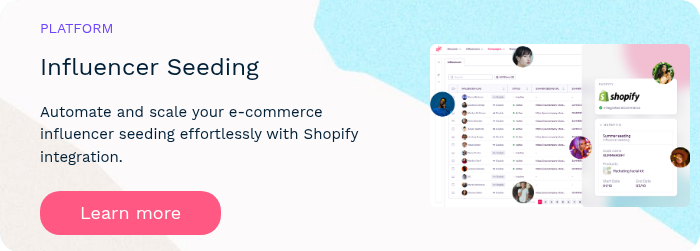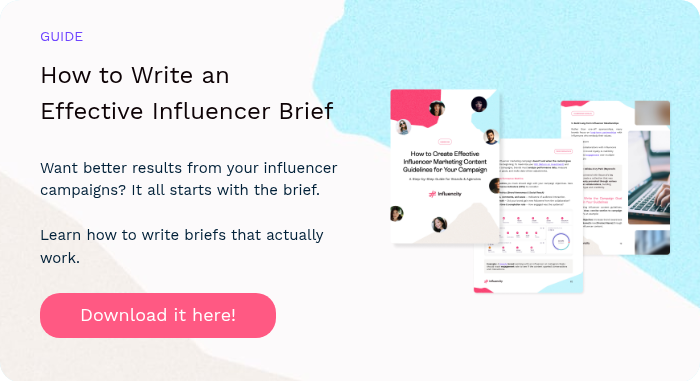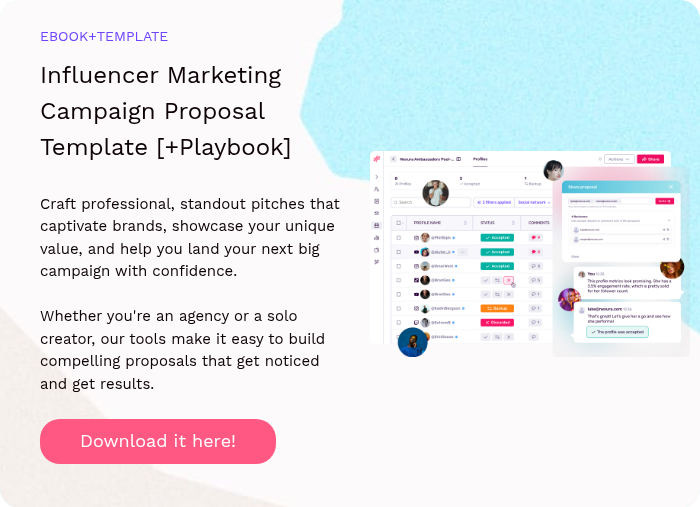82 min read
August 13, 2025
Aug 13, 2025
The Best Content Types for Agency-Run Influencer Campaigns
Written by: Jackie Zote
When you’re running an influencer campaign as an agency, your content planning relies heavily on the needs and goals of your clients. You need to strategically lay out the content types that work best depending on campaign goals. This typically involves structuring the goals by funnel stage and then deciding which types of content will work at each stage.
In my time researching influencer campaign case studies from different agencies, I’ve noticed a few things: Entertaining content was often used at the awareness stage while educational content was used to drive engagement. Content featuring promos and offers was typically used for sales-focused campaigns.
Similarly, agencies need to carefully plan out the content types to use for different campaigns to drive results. In this post, I share guidelines on the best content types for different funnel stages and the best practices to streamline content planning.
Top-of-the-Funnel Content Types (Awareness)
For campaigns with top-of-the-funnel goals like raising brand awareness or attracting followers, it’s all about boosting visibility and reach. That’s why the focus should be around entertaining content and formats that are proven to drive impressions, such as Reels. Make the most of trending sounds and content styles that could help you attract user attention and boost your visibility in relevant For You or Explore pages.
Here are some of the best content types for campaigns that focus on top-of-the-funnel goals.
First Impressions/Unboxing Reels
At the awareness stage, you want influencers to introduce people to the brand. Content that focuses on sharing first impressions and unboxing experiences can be a great way to take the audience along on the journey as influencers get a first look at the brand’s products. This helps to showcase authentic reactions, giving their followers a glimpse into the experience they could get to enjoy if they decide to buy from the brand.
Even if the influencer is already familiar with the brand, they could create this type of content to promote a new product or collection. Combine them with product seeding campaigns where you send influencers free products to try.
For this content style, Reels are an excellent format as they tend to get higher impressions than other content formats. Plus, the audio-visual nature helps to immerse viewers in the experience.
The following influencer created a first impression Reel where she tried out all the BALMADE Tinted Lip Balms from Milk Makeup. She included a voiceover describing the scent of each shade and explaining how she feels about it.
Before and After Showcases
Proving what your product can do through before and after showcases is the perfect way to grab attention while gaining instant trust with the audience. This is particularly effective if the influencer’s really good at telling an intriguing story or creating visual transitions. So they can create more awareness about your brand as they generate views for the content.
For this type of content to work, however, it needs to go hand-in-hand with eye-catching thumbnails or visual elements that would get people to pay attention to the content.
In the following Reel, the influencer shares the day-by-day progress as she uses the 345 Relief Cream from Dr. Althea. She shares visuals of her skin before and after using the product, helping to intrigue the audience.
Giveaway Collaborations
Giveaways may technically be great for boosting engagement. But what they do even better is generate awareness with an audience that may have never heard of your brand before. When influencers create content promoting your giveaway, it encourages people to engage with the post in the hopes of winning something.
This may involve tagging friends in the comments or sharing the giveaway post with their followers. So they help to expose your giveaway collaboration to a new audience, which exponentially increases brand awareness.
Sometimes, the “influencers” your clients work with for these types of collaborations may not necessarily be individual creators. Instead, they could consider partnerships with other influential brands that have overlapping audiences for an even more enticing prize. See how Glow Recipe partners with Poppi to create a themed giveaway for National Watermelon Day.
Entertaining Skits and Comedy Sketches
Nothing beats entertainment when it comes to attracting and engaging an audience. With the right approach, even a seemingly boring product can turn into a best-seller. That’s why entertainment content like skits and comedy sketches are great for gaining virality and boosting awareness.
For best results, focus on short video content formats like Reels and TikToks to execute this type of content. These content types are highly favored by social media algorithms, making it easier to increase content reach. Plus, the audio-visual nature of short-form video ups the entertainment factor.
The following creator came up with a funny skit depicting a “Crunchy Mom at a Soccer Game” to promote Peelz Citrus mandarins. This video alone garnered over 53k likes while the campaign as a whole saw over 7.8 million Reels impressions across various influencer content.
Middle-of-the-Funnel Content Types (Engagement)
If you’re running a campaign with middle-of-the-funnel goals like engagement, you’ll want to focus on value-driven content. This mainly involves educational or informative content types that offer a deeper understanding of the brand and its products.
For instance, you could focus on content that teaches the audience how to use a certain product or how to create a specific dish or makeup look. Or you could have your influencers create content that explains what ingredients are used and how they address specific concerns.
How-to/Demo Videos
Influencer content that teaches people how to do something is highly likely to capture audience engagement. That’s because they’re learning something useful from it – whether it’s a step-by-step instruction on the process, a demonstration of how the product works, or a collection of ideas to make the most of the product.
In the following partnership with Nature’s Path Organic, the influencer shares the process of putting together a healthy smoothie bowl using the brand’s product.
Meanwhile, the following influencer demonstrates a few ideas to shape lips using products from ColourPop Cosmetics. This could inspire her followers to recreate those looks and try the products themselves.
Your clients could even reuse this type of influencer-generated content in their content calendar. Diversifying branded content with organic how-to and demo videos from creators could keep their feed fresh and engaging while boosting the trust factor.
Unfiltered Reviews/Reactions
Authentic influencer UGC like unfiltered reviews and reaction videos are perfect for engaging audiences and earning their trust. Content that shows real people trying the brand’s product and sharing their real opinions offer value to shoppers who are interested in buying. It helps with the research process and satisfies their curiosity as they try to figure out whether the product is really worth the hype.
If the reviews or reactions come from creators they already trust and influencers who are known for their honesty, that’s even better. It could start a conversation around the product and even open the doors for buying discussions as people ask more questions before they’re ready to buy.
Keep in mind, however, that while a positive reaction could drive buying decisions, a negative one could harm brand reputation. So this content type really only works if your client sells a product they truly believe in.
Huda Beauty reshared the following honest review from an influencer known for testing viral products. The video featured Huda Kattan showing how her lip stain didn’t smudge or transfer even as she ate. Not being convinced, the influencer put the product to the test herself and was surprised to see that it really worked as showcased.
The video received tons of views and engagements from people who were looking forward to her honest reaction. It also boosted trust in the product, giving customers an even better reason to buy it.
Bottom-of-the-Funnel Content Types (Conversion)
When you’re running a campaign with bottom-of-the-funnel goals like sales and conversions, you need content that gives people a reason to take action. Think: limited-time offers and discounts or even shoppable content that streamlines the buying journey.
At this stage, it’s all about removing barriers to purchase (high price points, lengthy buying process, etc.) So content types that help to simplify the customer journey will help make it easier to drive conversions.
Discounts and Promos
Content promoting a discount or offer is highly effective for driving direct purchases through your influencer campaign. This typically involves providing influencers with a unique discount code that their followers can use. So you can easily track code usage and measure the influencer’s effectiveness in driving conversions.
Alternatively, you can also recruit influencers to spread the word about a sitewide sale or offer to help maximize sales. That’s what Purito did for their influencer campaign, which helped them promote their 30% discount on Amazon. This generated over 13.1k link clicks across 100 pieces of influencer content.
This type of conversion-focused content can be used in combination with some of the other content types highlighted above. In particular, content sharing how-to instructions or honest reviews can be very effective when you combine them with discounts and promo offers.
Content with Shoppable Product Tags
Shoppable product tags are a great way to shorten the buying journey and drive conversions. These tags make it easier for customers to take a closer look at the product, learn more about it, and even make instant purchases. That means they don’t necessarily have to leave the platform to convert, which removes barriers to purchase.
On platforms like Instagram and TikTok, creators can add shoppable tags to the products they feature in their content. Even if this capability isn’t accessible to every creator, brands can still reuse influencer-generated content for their shoppable posts. This adds authenticity and relatability as it showcases real people using the product.
See how Selkie reuses influencer content to share shoppable tags for their products.
Content Planning Best Practices and Tips for Agencies
Knowing what types of content to use for your influencer campaigns is one thing. It’s another to organize your efforts so you can build effective content plans for each client. Here are some tips and best practices to improve content planning for agencies.
Use Content Frameworks to Streamline Your Planning
Content frameworks help you take an organized approach to planning the best content types for your influencer campaigns. Depending on the industry and campaign goal of each client, you can decide which of the popular frameworks would be most effective.
For example, the PAS (problem-agitate-solution) framework is effective for addressing customer pain points. Meanwhile, the AIDA (attention-interest-desire-action) framework would be great for attracting customers who aren’t actively looking to buy.
Build Modular Briefs and Adapt Them for Different Platforms
When building out influencer briefs, it’s important to consider the content formats and styles that work best on different social platforms. That’s why you need to make your briefs modular, so you can easily adapt them based on the platform. This saves you the trouble of having to create new briefs from scratch every time.
Create Multi-Format Briefs from the Start
Similarly, the formats you need to use may vary depending on the campaign. So it’s best if you create multi-format briefs, as it’ll be easier to modify them according to your campaign needs.
This involves laying out briefs that cover all the different content formats that you might need to use across different client campaigns. You can then omit the formats you don’t need when customizing the brief for a specific campaign.
Plan with Repurposing in Mind
Some clients may want to reuse the influencer content for their brand’s social media or even their paid advertising campaigns. Make sure you plan your content with this in mind and try to maintain brand alignment even as you prioritize creative freedom.
Provide tips and guidelines on brand values, mission, and voice, so influencers can create content that’s aligned with your brand. This will help you repurpose the content more easily without the need to make drastic edits or changes.
Don’t Ignore the Approval Chain
When you’re creating influencer campaigns on behalf of clients, the influencer content will need to go through various approval stages before it goes live. Have a clear idea of the approval chain, so you can produce content that ticks all the boxes. During the initial planning stages, try to get clarification on who needs to sign off on the content. Then build this into your influencer guidelines and campaign workflow to minimize the back and forth.
Produce Impactful Influencer Content to Maximize Campaign Results
Most influencer campaigns rely on content to achieve their goals. That’s why you need to figure out the best content types to use for each goal as it will streamline your campaign planning. Use the tips and best practices shared above to produce more impactful content for your clients’ influencer campaigns.
Other posts you might be interested in
View All Posts
Social Media
32 min read
| September 3, 2025
Fake Engagement vs. Real Influence: How to Spot the Difference in 2025
Read More
Influencer Marketing
50 min read
| September 2, 2025
Affiliate Marketing Tactics That Actually Work for Brands & Influencers
Read More
Influencer Marketing
41 min read
| September 1, 2025




